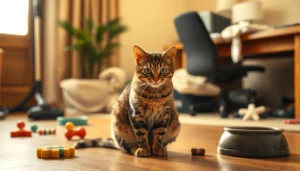Ever wondered why your cat seems irritated or distant? It might be because of things you do without realizing it. Cats have their own emotional needs, and what you think is loving could stress them out.
As a cat owner, it’s key to understand their behavior. Mistakes like too much petting or disturbing their space can upset them. These actions might make your cat unhappy with you.
In this guide, we’ll look at key behaviors that could harm your bond with your cat. We aim to strengthen your relationship by avoiding these mistakes.
Common Mistakes That Make Your Cat Uncomfortable
It’s key to know about cat behavior problems to live in harmony. Cats are sensitive and have their own likes and dislikes. To keep your cat happy, avoid actions that stress or upset them.
Many cat owners unknowingly upset their pets. They do this with actions meant to be loving but are not. Cats talk differently than humans, and what you see as love might bother them.
👉 Forced Physical Contact and Unwanted Petting
Unwanted touch is a big annoyance for cats. They don’t always want to cuddle or be petted. Forcing them can cause:
- More stress and anxiety
- Aggressive behavior
- Damage to your bond with them
“Respect your cat’s boundaries and let them initiate contact.” – Feline Behavior Expert
👉 Respecting Personal Space
Cats like their space and are territorial. Always invading their space can scare and upset them. Watch for signs they want to be alone.
👉 Protecting Their Sleep Schedule
Cats sleep a lot. Waking them up can make them grumpy and stressed. Make a quiet place for them to sleep without being disturbed.
Understanding and respecting your cat’s needs helps build a strong bond. It ensures their happiness and well-being.
Things You Do That Your Cat Hates During Daily Interactions
Knowing how to read cat body language is key to a good relationship with your cat. Cats are very sensitive and can get stressed by simple things we do every day.
Spotting what stresses cats out helps you avoid actions that upset them. Cats show signs of stress in subtle ways. If you’re not careful, you might miss them.
- Loud sudden noises can trigger signs your cat is unhappy
- Unexpected physical contact may cause significant stress
- Rapid movements can startle and frighten your cat
Cats like things to be calm and predictable. When you want to pet your cat, do it slowly. Let them decide if they want to be touched. Look out for signs like flattened ears or a swishing tail. These mean they might be uncomfortable.
It’s important to respect your cat’s space. Some cats like being petted, while others don’t. Knowing what your cat likes helps keep your relationship strong.
Respect your cat’s space and they’ll be more likely to seek out your companionship willingly.
By understanding these subtle signals, you can make your cat’s life more peaceful and stress-free.
Surprising Environmental Changes That Stress Your Cat
Cats love routine and predictability. Unexpected changes in their environment can stress them out. Knowing how your cat sees their world helps make their space more comfortable and safe.
Cats bond deeply with their homes. Even small changes can upset them. Their keen sense of territory makes them anxious when things change.
Navigating Furniture Rearrangement
When furniture moves, cats feel lost and scared. To help them, you can:
- Make changes slowly
- Keep some things the same
- Give them places to hide
- Use calming sprays
Introducing New Family Members
Introducing new people or pets to your cat takes time and patience. Cats need to get used to new faces.
“Cats are territorial animals who require gentle, slow transitions to feel secure.” – Veterinary Behavioral Specialist
Litter Box Location Matters
Cats are very picky about where they go to the bathroom. Moving their litter box can stress them out and even cause accidents.
- Don’t move litter boxes suddenly
- Gradually introduce new locations
- Have more than one litter box
- Place them in quiet spots
Remember, your cat’s comfort depends on consistency and understanding their unique sensitivities.
Feeding and Food-Related Behaviors to Avoid
Learning how to keep your cat happy starts with their feeding routine. Many cat owners make mistakes that stress their cats during meals.
Your cat’s mealtime is very important. Things that upset your cat often involve food. These behaviors can make them uncomfortable and lose trust.
- Never interrupt your cat while eating
- Maintain a consistent feeding schedule
- Avoid placing food bowls in noisy or high-traffic areas
- Keep food and water bowls clean
Common mistakes include sudden changes in food brands or inconsistent portions. Cats love routine and predictability. Sudden changes can upset their stomachs and make them anxious.
Pro tip: Always introduce new foods gradually. Start by mixing a little new food with their usual diet. Slowly increase the new food over several days. This helps prevent upset stomachs and ensures they like the new food.
Respect your cat’s eating space as if it were their personal sanctuary.
Fresh water is key. Change water bowls daily and keep them away from food. Cats are picky about their water. If they don’t like it, they might not drink enough.
Body Language Signals That Show Your Cat Is Unhappy
Understanding cat body language is key to a good relationship with your cat. Cats talk a lot through their body language. Knowing when your cat is unhappy can stop problems before they start.
Cats are experts at not talking. Their body language tells us a lot about how they feel. This lets us know what they need and how they’re feeling.
Decoding Tail Movements
Your cat’s tail is very important. It shows their mood in different ways:
- A puffed-up, bristling tail means they’re very scared or angry
- A tail held low or tucked between legs shows they’re anxious
- A tail that’s twitching fast usually means they’re upset or angry
Reading Ear and Whisker Signals
Small changes in ears and whiskers tell us a lot about your cat’s feelings:
- Flattened ears pressed against the head mean they’re scared or giving in
- Ears turned backward show they’re too excited
- Whiskers pulled tight against the face mean they’re stressed
Vocal Signals of Distress
Cats also talk with their voices. Excessive meowing, growling, or strange sounds mean they’re unhappy.
Learning to understand these signals makes your relationship with your cat better.
Building Trust and Maintaining a Happy Relationship With Your Cat
Building a strong bond with your cat takes patience and understanding. It starts with respecting their unique personality and learning to communicate with them. This means getting to know them on their terms.
To keep your cat happy, focus on these key strategies:
- Establish a predictable daily routine
- Provide interactive play sessions
- Create safe spaces throughout your home
- Use gentle, positive reinforcement
Understanding your cat’s body language and emotional needs is key. Cats like owners who can read their subtle signals. Watch for their tail movements, ear positions, and vocal cues to know how they’re feeling.
Interactive play is vital for building trust. Use toys that mimic hunting, like feather wands or laser pointers. These activities keep their minds sharp and strengthen your bond.
“A cat’s trust is earned through respect and consistency” – Feline Behavior Expert
Every cat is unique. Some like little contact, while others love cuddles. Watch what your cat prefers and adjust your approach. Being patient and gentle will help you build a deep connection with your cat.
Conclusion
Knowing what your cat dislikes is key to a strong bond. Cats are complex, with their own personalities and feelings. By understanding their limits and signals, you can make your home a happier place for them.
To keep your cat happy, it’s not just about food and a place to sleep. You need patience, to watch them closely, and be ready to change how you act. Even small changes can help a lot. Showing respect for their space and understanding their body language can strengthen your connection.
Making your cat comfortable is all about empathy and knowing them well. Listen to what they need, learn how they communicate, and be gentle. Every cat is unique, so what works for one might not work for another. By learning and responding to your cat’s needs, you’ll deepen your relationship.
The main goal is to make a loving, stress-free home for your cat. By using the tips from this guide, you’ll avoid upsetting your cat and build a deep understanding. This will make your lives richer together.
FAQ
Why do cats seem to hate being touched in certain areas?
Cats don’t like being touched in sensitive spots like their belly, tail base, and paws. These areas are vulnerable and can make them defensive. Each cat is different, so it’s important to respect their boundaries to avoid stress or discomfort.
How can I tell if my cat is stressed by my actions?
Watch for signs like flattened ears, a swishing tail, and dilated pupils. If your cat hides or grows, they might be stressed. If you see these signs, give them space and avoid what’s causing their stress.
Is it bad to wake my cat up from sleep?
Yes, it’s very bad! Cats sleep a lot, up to 16 hours a day. Waking them up can make them cranky and stressed. Let them wake up naturally and avoid disturbing them during sleep.
Why does my cat get upset when I rearrange furniture?
Cats like routine and territory. Changes can stress them out. When you rearrange furniture, do it slowly and provide safe zones for them to adjust.
How can I show affection to my cat without making them uncomfortable?
Let your cat choose when to be touched. Pet them gently in places they like, like under the chin or behind the ears. Slow blinks can show trust. Interactive play is better than forced contact.
What common household sounds might be stressing out my cat?
Cats don’t like loud or sudden noises like vacuum cleaners or blenders. These can scare them. Try to keep it quiet and create a safe space for your cat.
How often should I change my cat’s litter box location?
Never move your cat’s litter box suddenly. Cats are very territorial about their bathroom space. If you must move it, do it slowly over several days. Sudden changes can cause stress and litter box avoidance.
Can playing too rough harm my relationship with my cat?
Yes, rough play can hurt trust and make your cat fearful. Use toys for play, not your hands. Gentle, predictable play builds a strong bond with your cat.



